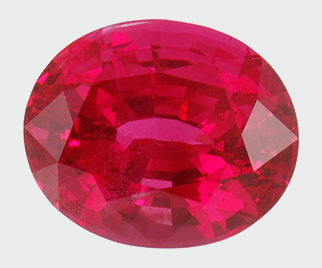The Gemstone Spinel

Spinel is most famous for its deep red variety that closely resembles Ruby. These two gemstones can be very difficult to
distinguish. Until the late 19th century, there was no distinction made
between Ruby and red Spinel, as they look identical and are found in the
same localities. Many famous old "Rubies" were discovered to be in
fact Spinel. For example, the enormous "Ruby" that forms the centerpiece
of the royal crown of England (the Black Prince's Ruby) was actually
determined to be Spinel.
Color
?
White, Colorless, Blue, Red, Green, Yellow, Orange, Brown, Pink, Purple, Black
Chemical Formula
?
MgAl
2O
4
All About
Spinel is a gemstone that comes in a variety of colors.
Pure Spinel
is colorless, but
impurities are responsible for the wide range of
colors.
The most valuable and desirable Spinel color is a deep blood red,
though blue, yellow, orange, pink, and purple colors also make fine
gemstones. Spinel is often
fluorescent in
ultraviolet light, and this can be helpful in its identification.
Fine red Spinel is actually rarer than Ruby of equal
color. However, its is an undervalued gemstone, with its cost is about
30% lower then comparable Ruby. The scarcity of good Spinel is the
reason for its lack of demand and popularity. Gem Spinel is in very limited supply, and therefore jewelry companies and gem cartels don't really market this gemstone to the consumer. This inhibits Spinel from being a more mainstream gemstone.
Spinel is easily
synthesized, and can be made into any color by adding
impurities.
Synthetic Spinel is often simulated to replicate many other gemstones
such as
Diamond,
Sapphire, and
Zircon. Because of the
abundance of synthetic Spinel, one must always be careful only to
purchase this gemstone from reputable dealers. Almost all colorless
Spinel gemstones are synthetic, as it rarely occurs colorless in nature.
Uses
?
The deep-red variety, often called
Ruby Spinel, is the most prized
form, and is a very good substitute for
Ruby.
Spinel is also an important pink gemstone. The opaque, black variety, known as
Pleonast, has a good luster and is used as a black gemstone.
Spinel
naturally occurs in
octahedral crystals. In well-shaped red
crystals, gem cutters may even out a crystal into a perfect
octahedron. These "crystals" are occasionally be worn in jewelry
without any further faceting.
Treatments & Enhancements
?
Natural Spinel gemstones are not treated or enhanced.
Spinel Sources
?
The most outstanding Spinel in size, color, and quality is from Burma.
Other sources of gem Spinel are Sri Lanka, Cambodia, Vietnam, Thailand,
Tadjikistan, Afghanistan, Pakistan, Tanzania, and Madagascar.
Similar Gemstones
?
Red Spinel can be identical in appearance to
Ruby. However,
Spinel is usually lighter in color, and the deep-red Spinel is usually
more of a brick-red then the Red of Ruby which has a slight blue or
purple tinge to it. However, only optical properties and
hardness
can truly distinguish these two gemstones. Red Spinel can also closely
resemble red
Tourmaline and dark red Spinel may resemble
Garnet.
Blue Spinel may resemble
Zircon,
Topaz, and
Sapphire; and pink Spinel may resemble
Morganite, pink
Topaz, and pink
Tourmaline. Purple Spinel may appear similar to
Amethyst, though Spinel is usually bluer in tone than Amethyst.
Spinel in the Rough Photos
?